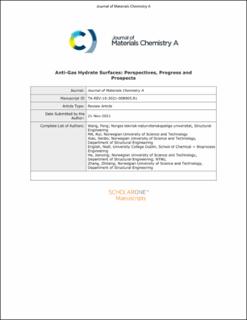| dc.description.abstract | Mitigating gas-hydrate formation and the subsequent gas-pipeline plugging is of critical importance for ensuring both flow assurance and safety in the exploration and transportation of deep-water resources. Until now, active methods that use chemicals and thermal energy have been mainly applied in tackling the unwanted hydrate-accumulation problems. However, these methods not only are costly in and of themselves, but can also result in unavoidable environmental concerns. The rapid developments in surface-modification technology and advanced surface designs offer alternative solutions to mitigate the challenges raised by gas-hydrate formation. Newly reported surfaces possess great potential for depressing gas-hydrate nucleation and deposition, and lowering hydrate adhesion, which has made passive anti-hydrate strategies possible. In this review, three current research priorities are pinpointed. Firstly, the intrinsic interactions between a solid surface and gas hydrate should be scrutinized, which can shed light on solving the complex role of surface properties in hydrate nucleation. Secondly, hydrate-deposition mechanisms and surfaces that could suppress hydrate deposition need to be well understood, and, indeed, manipulated in their design. Of course, gas-hydrate deposition is more than a sequential process of hydrate agglomeration, and should be highly related to the underlying molecular chemistry/physics of surfaces. Thirdly, hydrate adhesion from nano- to continuum-scales need to be correlated and understood well in terms of transition from one regime to the other; in such a way, this will facilitate the design of surfaces with low hydrate adhesion. After a thorough review on the fundamental relationships between surfaces and hydrate nucleation, deposition and adhesion, we shall discuss promising progress in gas-hydrate-inhibiting surfaces from the perspective of suppressing hydrate nucleation, inhibiting hydrate deposition and lowering hydrate adhesion, as well as gauging prospects for interesting directions in developing a comprehensive knowledge base for the design and creation of next-generation multifunctional hydrate-phobic surfaces. | en_US |
